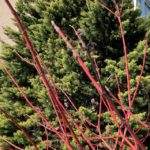Remove dust from your house plants by rinsing them in the shower.
February #2 (Indoor)
February #2 (Outdoor)
Barrenwort (Epimedium) and Lungwort (Pulmonaria) will be in flower soon. Cut back last year’s foliage before new growth appears.
February #1 (Outdoor)
Bluebirds are already looking for a place to nest, so clean out your birdhouse soon. If you are in need of a good bluebird house, check out Homes for Bluebirds,…
February #1 (Indoor)
Sow broccoli, cauliflower and cabbage seed indoors now or buy transplants in March. Harden them off before planting out in March.
UT Gardens’ January 2020 Plant of the Month: Silky Dogwood
January #6 (Indoor)
Study seed catalogs if the cold days of winter seem unrelenting, and dream of lush, warmer days.
January #5 (Indoor)
Keep a check on stored garden produce such as potatoes, turnips, winter squash, apples and pears for bad spots that may lead to decay. Remove them and use those with…
January #5 (Outdoor)
Pansies will benefit if you pinch off their withered and cold-damaged blooms.
January #4 (Outdoor)
As long as the ground is not frozen, you can continue to plant new trees and shrubs, just tuck them in with a 2- or 3-inch layer of mulch. Remember…
January #4 (Indoor)
For some added color and fragrance during the bleak days on January and February, check out your local garden center for leftover paperwhite and amaryllis bulbs that are likely to…
